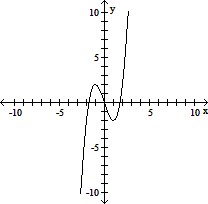Estimate by rounding as directed. 6.06 + 0.013 + 0.197; nearest one
A. 6.27
B. 7
C. 6.3
D. 6
Answer: D
You might also like to view...
Use the graph of the function f(x) to locate the local extrema and identify the intervals where the function is concave up and concave down.
A. Local minimum at x = 1; local maximum at x =-1; concave down on (0, ?); concave up on (-?, 0) B. Local maximum at x = 1; local minimum at x =-1; concave up on (0, ?); concave down on (-?, 0) C. Local minimum at x = 1; local maximum at x =-1; concave up on (0, ?); concave down on (-?, 0) D. Local maximum at x = 1; local minimum at x =-1; concave up on (-?, ?)
Evaluate the integral.
A.  ln 7x -
ln 7x -  + 2x + C
+ 2x + C
B.  ln 7x - x2 + x + C
ln 7x - x2 + x + C
C.  ln 7x -
ln 7x -  + x + C
+ x + C
D.  ln 7x -
ln 7x -  + x + C
+ x + C
The following question refers to a school district with three high schools. The total number of students in the district is 3000. The teachers within the district are apportioned to the high schools based on the schools' respective enrollments. The standard quota for each school is given in the following table. What does the standard divisor represent in this apportionment problem?
What does the standard divisor represent in this apportionment problem?
A. the number of teachers per 100 students B. the number of students per teacher C. the number of teachers required for 3000 students D. the number of students per 100 teachers E. none of these
Find the slope of the line through the pair of points.(-1, -6) and (7, -3)
A. - 
B. - 
C. 
D. 